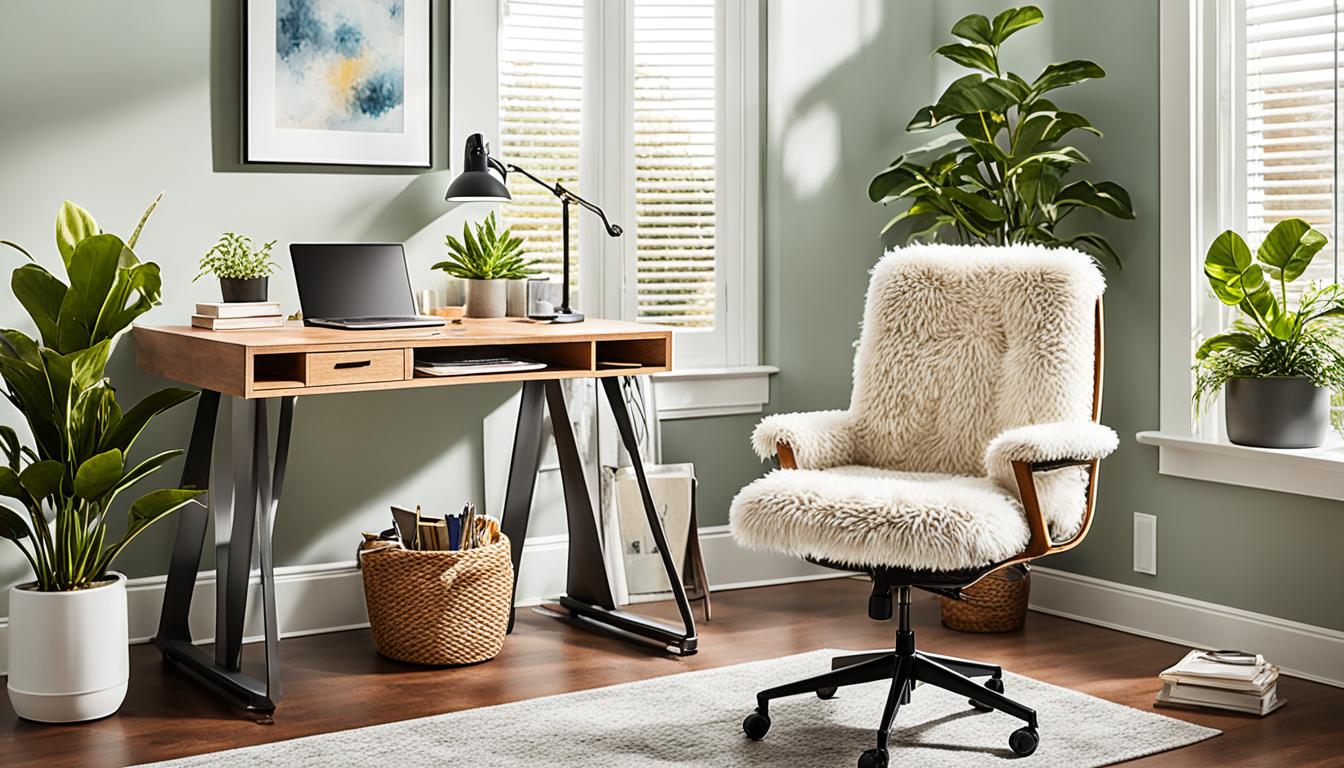As the husband of a woman with endometriosis and fibromyalgia, I’ve seen how a well-designed home office helps with chronic pain. Many chronic conditions need changes in the home. A good environment at home is key for long-term care and comfort.1 Have you thought about how your home office decor could help with chronic pain? Let’s look at this idea closely.
Chronic illnesses can affect a person’s body, feelings, and social life.1 It’s very important for those with these illnesses to have the right home environment. Making changes to how a home is designed can lower stress for such patients. This article will show how changing your home office decor can help with chronic pain. It can also increase work productivity and turn your workspace into a soothing place.
Introduction to Chronic Illness and Home Design
Dealing with chronic illness can be tough, but smart home design helps a lot. Illnesses like fibromyalgia, back pain, and migraines can really mess with someone. Their body, mind, and how they connect with others can be deeply influenced. Getting diagnosed early and starting treatment soon matters a great deal. But, the house where someone lives makes a big difference too.
Understanding Chronic Conditions
Chronic illnesses stick around for a long time, needing constant care. Be it tough arthritis or challenging Alzheimer’s, they change how we live each day. They can limit what we do, where we go, and our freedom.1 Designing a home to help with these special needs is crucial.
The Importance of Individualized Design
Chronic diseases hit each person uniquely. Maybe someone’s very tired, or they can’t move much. Perhaps, they have trouble thinking, or their senses are extra sensitive. Making a space that meets these special needs is essential. It really helps with long-term care and support.1 This tailored design lets people keep their freedom, handle symptoms, and live well in their own house.
Going Beyond ADA Compliance
Starting with ADA compliance is a good step for easier public access. But when designing a home, we should think further than ADA rules. Sometimes we need to change things based on a person’s special needs. For example, a person with Parkinson’s Disease might need a gentler ramp. This would make their journey safer and more comfortable than what ADA requires.2
Having enough seats on public transport for those who need them, like the disabled and pregnant women, is very important. Also, ensuring there’s enough seating at bus stops and train stations matters. Plus, we should think about the concept of “spoons”, which represents energy levels. It’s crucial for those with disabilities, helping them plan their day better.2
By customizing home office design according to special needs, we create a place of comfort and productivity. This approach is especially helpful for people with chronic conditions, such as Parkinson’s Disease. They get better accessibility and mobility in their space, while using walking aids.2
Incorporating Assistive Equipment
The right tech and gear can change someone’s life with a long-term illness.1 But, sometimes houses make it hard to move around. They’re not wide enough for walkers or wheelchairs.1
Creating Maneuverable Spaces
To make a home work for everyone, it should fit today’s tools and tomorrow’s needs.1 Adding things like walkers to the office plan can give more freedom. This helps people with health issues get around better.1
Planning for Future Needs
Health problems can get worse over time, so we need to plan ahead.1 Making rooms that can change with new gadgets and tools is key. It means the home office will always help the owner, no matter what.1
By setting up smart tech and space, a home office can be a safe place for those with long-term health problems.1 Adapting the space for now and later gives the owner the power to enjoy their own space.1
Pain Management through Design
Many long-term health issues need careful pain control.1 Even if physical pain meds aren’t needed, one might face difficulties like being touch-sensitive or feeling down. Thinking about how things are made and using special materials can help. This makes life more comfortable and calm for many.1
Ergonomic Considerations
Take arthritis, for instance. A warm bath can work wonders. For those with autism, quiet spaces with sound-absorbing stuff are vital.1 We can adjust our homes to suit these needs. For arthritis, this might mean having counters and tools that are easy to reach, plus things like grab bars about the house. These little changes can make big differences in daily comfort.1
Sensory-Friendly Materials
Handling pain is a big deal for many who face it for a long time.1 Warm baths can ease arthritis, while materials that dull sound are a must for those with autism. The goal is to design things that always help, letting people live on their own terms as much as possible.1
A Holistic Approach to Home Design
Designing a home for people with chronic conditions involves more than just functionality. The approach should boost physical and occupational therapy goals. It should also focus on the person’s mental, emotional, and social health. For instance, adding a cozy visitor area by the bed allows easy visits from loved ones.1
Fostering Independence
Fostering independence in home design for chronic illnesses is vital. Using universal design principles makes the space welcoming without highlighting the disability. The aim is to showcase the person’s abilities. This makes the home a place of comfort, inspiration, reflecting the individual’s unique needs.
Incorporating Personal Interests
People with progressive illnesses gain emotional support when their living space reflects them. The design should include their hobbies and interests. This could be a space for arts and crafts, a corner for reading, or a place for their favorite activities. Such design choices improve their happiness and life quality.
Taking a holistic view in designing homes for chronic conditions offers many benefits. It meets practical needs and enhances the person’s well-being and independence. This approach supports aging in place, keeping autonomy, and enjoying life at home.
Biophilic Design for Chronic Pain Relief
Living with a chronic condition, I’ve learned how much our spaces impact us. I’m drawn to biophilic design3 – it brings nature into our built spaces. This holistic method turns my home office into a peaceful spot. It calms both my thoughts and my body.
Bringing Nature Indoors
Biophilic design understands our need to be in nature. It brings the outdoors inside, using natural textures and materials. Studied show biophilic design boosts well-being and health. This is perfect for me with my chronic health issues.
I add plants, green walls, and natural materials to my office.3 This lets me be close to nature even indoors. It’s shown to reduce stress and make me feel calmer and more centered.
Natural Light and Ventilation
Good light and air matter a lot in biophilic design.3 More than 90% of our time is spent indoors, leading to health issues. I place my windows to let in as much light as possible. This brightens my mood and supports my cycle, helping me sleep better, too.3
Having good air in my office is also crucial.3 It keeps the space fresh and aids my focus. Natural air, along with greenery, makes my office a place of renewal. It eases both physical and emotional stress from my health condition.

Home Office Decor Chronic Pain Relief
Decorating your home office can help a lot with chronic pain. It also boosts how well you work. And it changes your workspace into a calm place. Key things to add are comfy furniture, like standing desks and chairs with back support. You should also use mats that help you not get tired, cushions that massage, lights that are good for you, air purifiers, and headphones that block noise. These items fight pain, lower tiredness, and help you concentrate and be happy.
Doctors recommend using good office furniture to stop back and neck pain. A lot of people hurt their backs and suffer from pain, and they really need that extra support. Big chairs that are very supportive make a huge difference. They help keep your lower back healthy and lessen pain there.4
Bad posture is a top reason for back pain. This shows how important good office furniture is. Special chairs help your back stay in its natural shape. They stop your pelvis and spine from getting too stressed. This kind of furniture makes you more comfy, helps you work well, and lessens back pain. It also makes you less tired.4
Chairs that match the natural curve of your spine are great because they stop your lower back from getting sore. Doing up your home office with these special things can help a lot if you have a chronic problem. It makes a setting that eases pain, helps you work better, and makes you feel good overall.
| Ergonomic Furniture | Benefits |
|---|---|
| Standing Desks | Reduced back and neck pain, improved posture, increased energy |
| Chairs with Lumbar Support | Alleviated lower back pain, improved spine alignment, reduced fatigue |
| Anti-Fatigue Mats | Decreased joint and muscle strain, enhanced comfort during prolonged sitting |
| Massage Cushions | Relieved muscle tension, improved circulation, decreased stress |
| Therapeutic Lighting | Reduced eye strain, improved mood and focus, enhanced sleep quality |
| Air Purifiers | Improved indoor air quality, reduced respiratory irritation, allergy relief |
| Noise-Cancelling Headphones | Diminished distractions, enhanced concentration, decreased stress and anxiety |
Ergonomic Office Furniture for Back Pain Relief
Aesthetics and Personal Style
Designing a home office for chronic pain relief is key. Focus on functionality and how it fits you. But don’t forget to add your personal style and what you love. This makes the office not just comfortable but also reflects who you are.5 By using universal design rules, the space fits everyone. It doesn’t spotlight your disability but your talents. This way, the home office becomes a place that’s uniquely yours, inspiring, and cozy.
Emphasizing Ability over Disability
For those with long-term health issues, a home office should do two things. First, it must work well for you. Second, it should let your personality shine through.5 The design is not about your health issue. Instead, it shows off what you’re good at. This is done by picking items that help, and look good too.
This choice makes the home office about what you can achieve. It gives you power and uplifts you. Contrary to a boring, hospital-like room, it reflects your tastes and dreams. Such a design boosts your mood, makes you work better, and improves life quality overall5.
| Design Element | Emphasis on Ability | Emphasis on Disability |
|---|---|---|
| Furniture | Ergonomic, adjustable, and customizable options that enhance comfort and support | Institutional-looking medical equipment or assistive devices that draw attention to limitations |
| Decor | Personalized artwork, plants, and accessories that reflect the individual’s interests and style | Clinical, impersonal, or overly institutional-looking decor that reinforces the idea of disability |
| Technology | Seamlessly integrated smart home features and assistive technology that enhance productivity and independence | Visible or obtrusive assistive devices that can make the individual feel self-conscious or singled out |
Focusing on what you can do and what you like in your home office matters. It makes you feel powerful and positive about your space. This approach helps you do better work and stay hopeful, even with health challenges.5
Designing for Specific Chronic Conditions
Designing a home office for people with chronic conditions means meeting their special needs. We can make a space that offers support and ease. Here, we’ll look at how to design for arthritis and dementia/Alzheimer’s.
Arthritis
Arthritis-friendly home offices have features to lessen physical effort and boost easy access. Think about placing work surfaces and tools at easy-to-reach heights1. Provide enough room and comfy seating for sitting while working1. Add grab bars and non-slip mats in key areas1, and choose kitchen items that are easy to handle1. A nice, relaxing bathtub can also bring relief to sore joints1.
Dementia and Alzheimer’s
For those in the early stages of dementia or Alzheimer’s, a special approach is needed. The office can start with basic safety systems and easy-to-see family photos. Switching plain cabinet doors to glass ones and using smart tools can help keep them secure. As their condition changes, add more protection against wandering and make sure there’s plenty of light to prevent falls.
Tailoring office designs to specific health needs enhances daily life. These spaces offer both practical aid and a feeling of well-being and independence.
The Benefits of Natural Materials
Living with chronic pain, I’ve seen how great natural materials are in my home office. Wood and stone make it look calming and feel good. They also give me a good feeling when I touch them.1
Incorporating Wood and Stone
In my home office, adding wood and stone made it inviting. The wood’s gentle lines and the stone’s coolness help me relax. This is great for those with ongoing health issues.1
Using wood and stone makes everything in my office work well together. They go well with other nature-inspired designs, like big windows and plants. It feels like I’m outside while indoors, which soothes me.1

More than looking nice, touching wood and stone is calming. Feeling a soft wooden piece or a smooth stone is soothing. It’s a big help for my pain and stress.1
Adding natural materials has really changed my office. It’s now a place of beauty, comfort, and connection to nature. This has helped me cope with my health troubles a lot.1
The Role of Color in Chronic Pain Relief
Color, color therapy, and calming colors are key in home office design for chronic pain relief. Hues like comforting blues and greens have shown to calm. They help ease stress and anxiety.
Using color strategically aids in seeking chronic pain relief. Studies reveal how colors affect our mood and mental health. For instance, warm tones boost energy, while cool ones bring peace.
Moreover, color in a home office can actually ease pain. Specific calming colors might reduce muscle tension, lower blood pressure, and ease headaches.6 This creates a calming sanctuary for those with chronic conditions.
Approaching color in design is vital for those with ongoing pain. Careful color selection not only meets their physical needs but also supports their mindset and emotions. It transforms a home office into a healing environment, boosting overall well-being.
Texture and Sensory Stimulation
Aside from color, adding different textures and sensory features helps with chronic pain and boosts overall happiness.7 These methods aim to make touch more clear, match sensations with reality, and ease ongoing pain for CRPS patients.7 By training the brain to feel and understand different touches, two-point accuracy gets better. This process has reduced pains in people with phantom limbs, CRPS, and chronic back issues.7
Tactile Experiences
Warm, fuzzy materials and soft textures help create calm, relieving both body and mind strain.7 People with CRPS suffer more in their daily lives compared to those with different types of chronic pain.7 Setting up spaces like a home office to focus on these textures can be very supportive for those with lasting pain.
Self-Care Practices and Interior Design
The way we design our homes affects how we take care of ourselves. It plays a big part in our happiness and health.8 When we set up places for peace, like a cozy spot or a meditation area, we’re more likely to relax and take care of ourselves.8 Features in our design can make us more mindful, help us deal with stress, and keep us comfy. These things all help in taking better care of ourselves and staying healthy over time.8
Creating Spaces for Relaxation
Finding a place to unwind at home is important.8 You can make rooms for quiet reading, meditation, or gentle exercises.8 Doing this helps us focus on taking care of ourselves. It can lower stress, ease pain, and fight off feelings of sadness.8
Encouraging Healthy Routines
Where we live affects our day-to-day routines a lot.8 Arranging our space at home to encourage health can lead to a better life. This could mean having desks that can adjust in height, comfy chairs, and plenty of sunlight. These things help us move more, be mindful, and relax during the day.83
Residential Design for Overall Well-being
A good residential design for chronic illness looks at many areas of well-being. These include your physical, mental, and social health, as well as your spiritual and financial aspects.8 Handling all these together helps make a living space that supports life quality. It helps you manage your chronic condition better.8 This kind of design really supports staying at home as you get older. It lets you stay independent and happy in your own place.
Designing a home that boosts your health and mood is important if you have a chronic condition.8 It includes making a space that is good for your health, easy to move around in, and comfortable.8 Adding things like natural light, plants, and soft materials can make you feel better. They reduce stress and even help with pain.9
It’s not just about the physical space. A good design also helps you connect with others and feel spiritually happy at home.8 There should be places for your hobbies and to meet with friends and family. This helps your emotional and social needs, and it can even help with money. It makes it easier to stay at home as you get older.8 This kind of total design can really lift up those with chronic conditions. It helps them to live well and independent, making their life better overall.
Source Links
- https://liveinplacedesigns.com/how-home-design-can-help-you-live-with-a-chronic-illness-or-condition/
- https://pedestrianobservations.com/2022/02/11/notes-on-accessibility-and-chronic-pain/
- https://www.ncbi.nlm.nih.gov/pmc/articles/PMC8871637/
- https://bodybilt.com/ergonomic-office-furniture-for-back-pain-relief-solutions-and-recommendations/
- https://jeweledinteriors.com/2021/04/home-office-ideas/
- https://www.ncbi.nlm.nih.gov/pmc/articles/PMC10457639/
- https://www.researchgate.net/publication/371170357_Sensory_training_system_for_use_at_home_by_people_with_complex_regional_pain_syndrome_in_England_protocol_for_a_proof-of-concept_study
- https://www.julieannrachelle.com/blended-decor-blog/wellness-design-for-chronic-illness
- https://www.mdpi.com/1660-4601/19/4/2248
